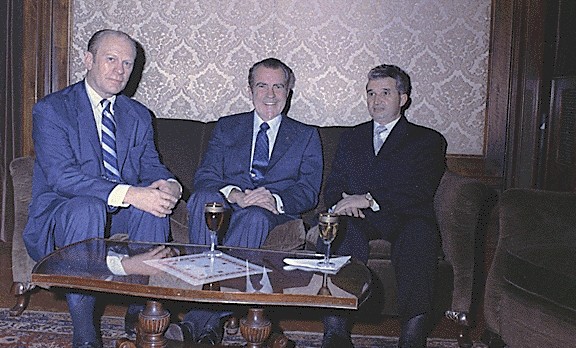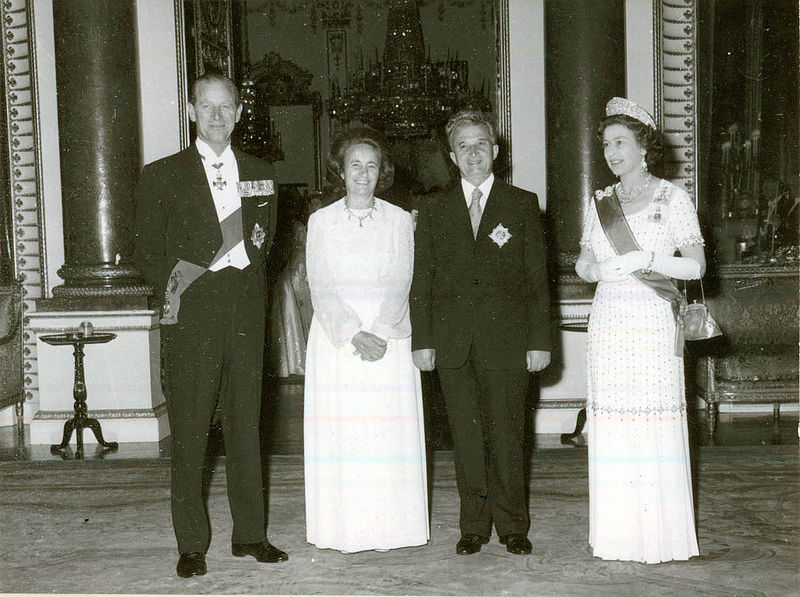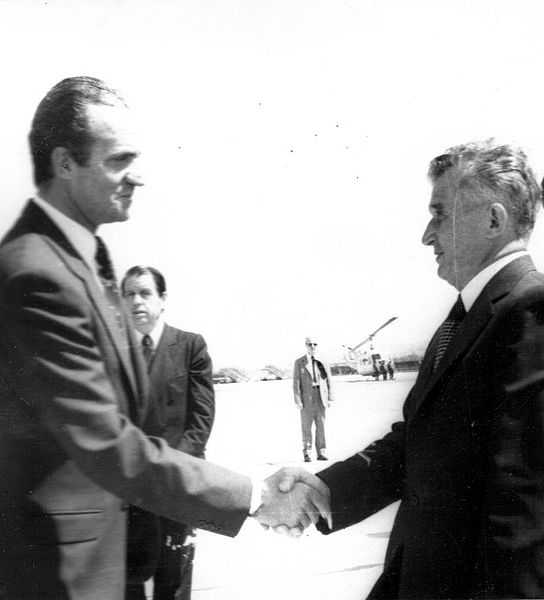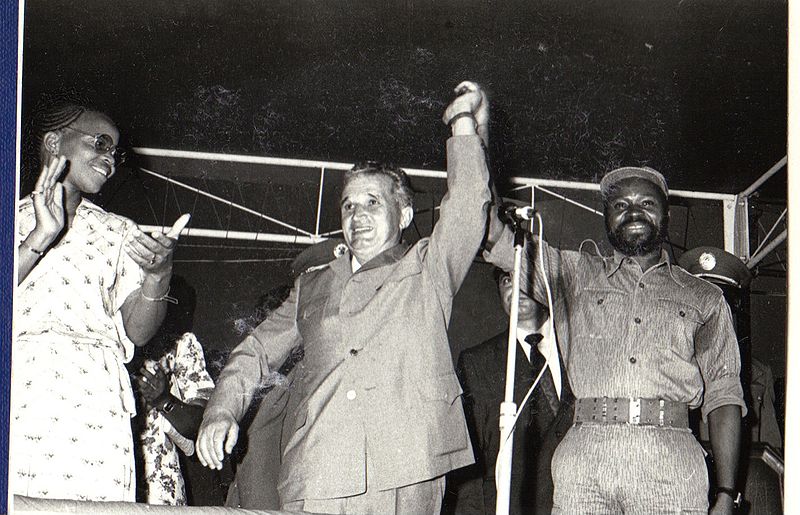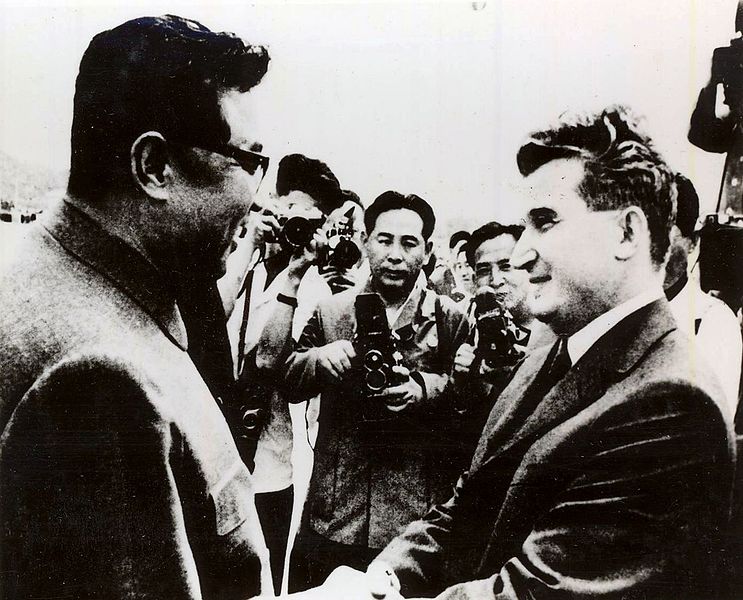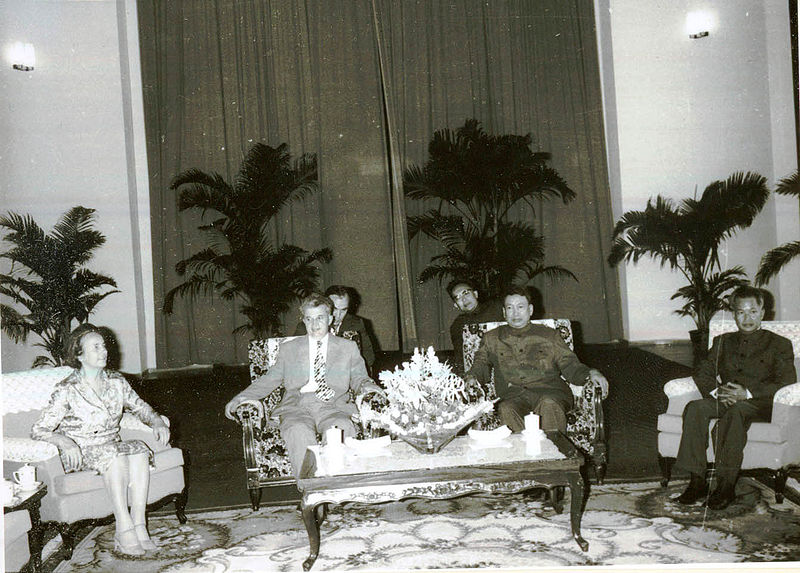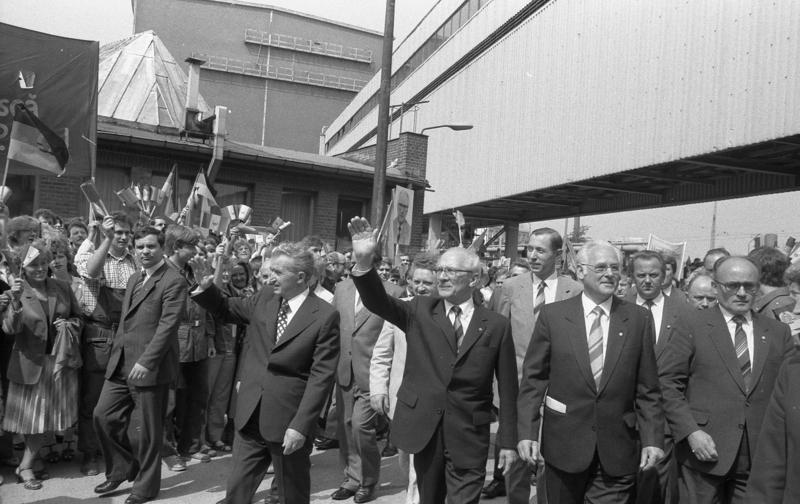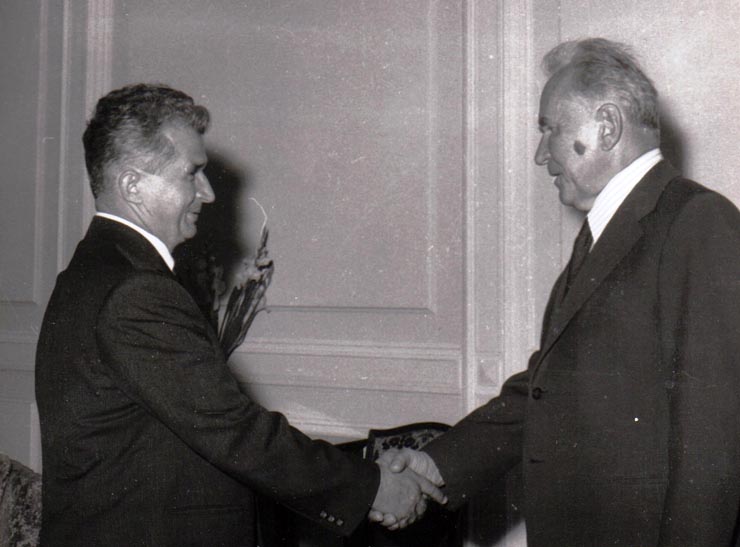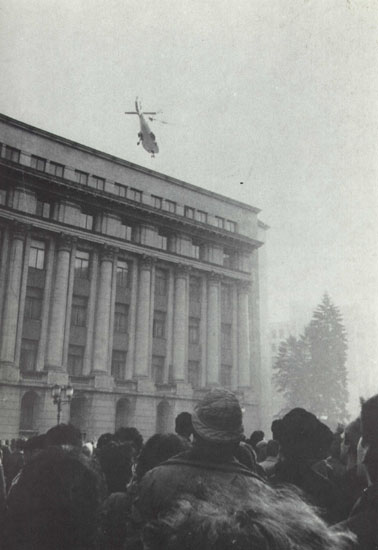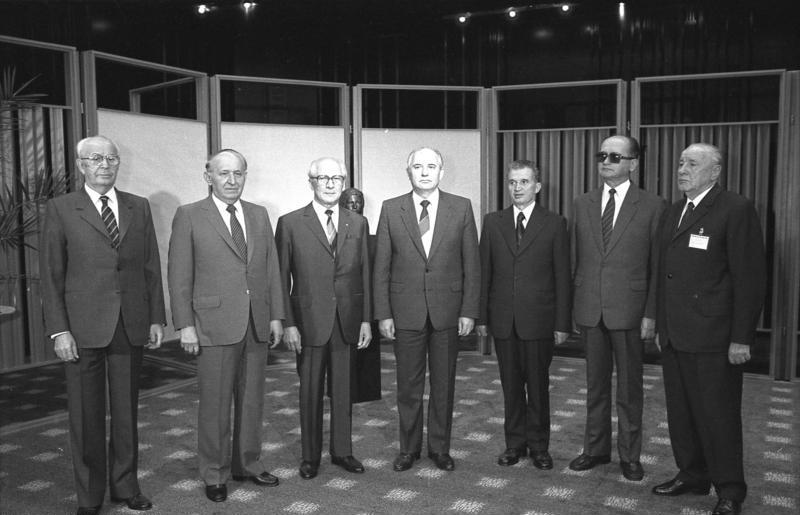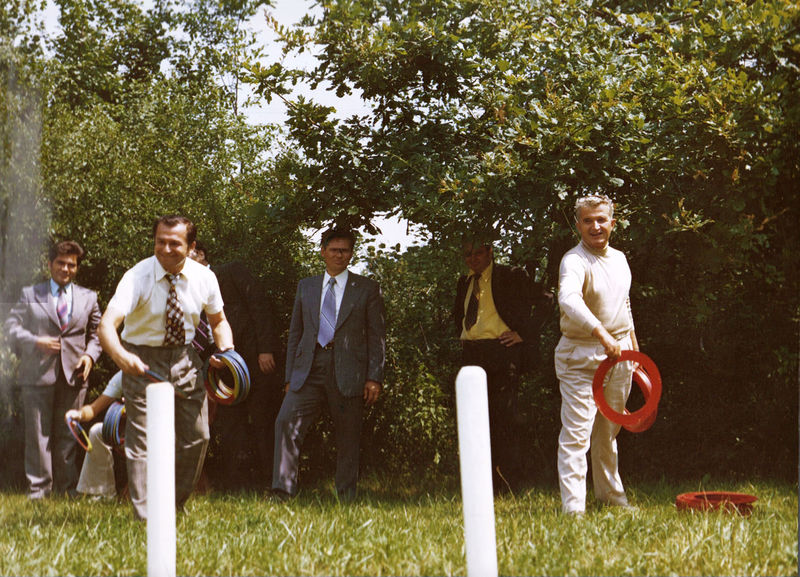<Back to Index>
- Explorer Pierre Paul François Camille Savorgnan de Brazza, 1852
- Painter Cornelis Theodorus Maria van Dongen, 1877
- General Secretary of the Romanian Communist Party Nicolae Ceauşescu, 1918
PAGE SPONSOR
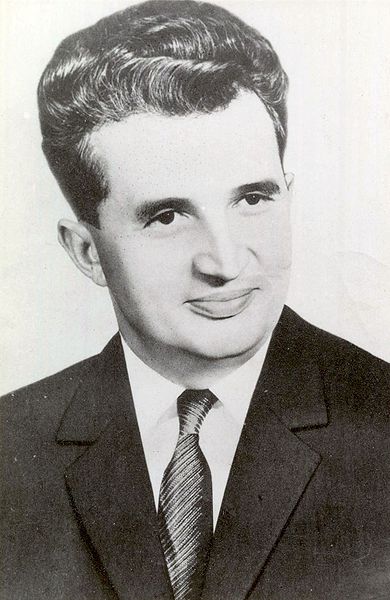
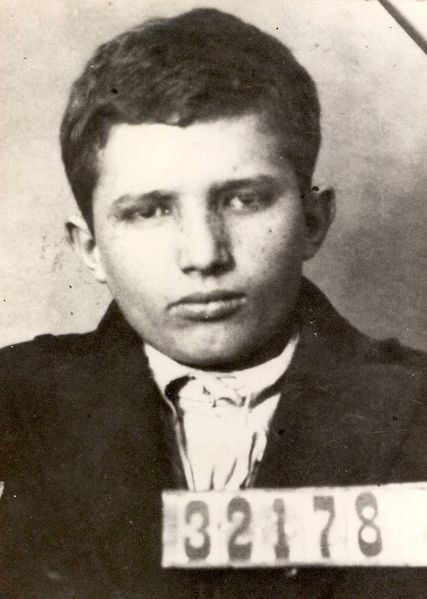
Nicolae Ceauşescu (26 January 1918 – 25 December 1989) was a Romanian politician and dictator who was the Secretary General of the Romanian Communist Party from 1965 to 1989, President of the Council of State from 1967, and President of Romania from 1974 to 1989.
His
rule was marked in the first decade by an open policy towards Western
Europe, Israel, and the United States, which deviated from that of the
other Warsaw Pact states during the Cold War. He continued a trend first established by his predecessor, Gheorghe Gheorghiu-Dej, who had tactfully coaxed the Soviet Union into withdrawing its troops from Romania in 1958. Ceauşescu's second decade was characterized by an increasingly erratic personality cult, nationalism and a deterioration in foreign relations with the Western powers as well as the Soviet Union. Ceauşescu's government was overthrown in a December 1989 revolution,
and he and his wife were executed following a televised and hastily
organised two-hour court session. One of the executioners later said:
"it wasn’t a trial, it was a political assassination in the middle of a
revolution." Born in the village of Scorniceşti, Olt County, Ceauşescu moved to Bucharest at the age of 11 to work in the factories. He was the son of a peasant. He joined the then-illegal Communist Party of Romania in
early 1932 and was first arrested, in 1933, for agitating during a
strike. He was arrested again, in 1934, first for collecting signatures
on a petition protesting the trial of railway workers and twice more
for other similar activities. These arrests earned him the description
"dangerous communist agitator" and "active distributor of communist and
anti-fascist propaganda" on his police record. He then went
underground, but was captured and imprisoned in 1936 for two years at Doftana Prison for anti-fascist activities. While out of jail in 1940, he met Elena Petrescu,
whom he married in 1946 and who would play an increasing role in his
political life over the years. He was arrested and imprisoned again in
1940. In 1943, he was transferred to Târgu Jiu internment camp where he shared a cell with Gheorghe Gheorghiu-Dej, becoming his protégé. After World War II, when Romania was beginning to fall under Soviet influence, he served as secretary of the Union of Communist Youth (1944 – 1945). After
the Communists seized power in Romania in 1947, he headed the Ministry
of Agriculture, then served as Deputy Minister of the Armed Forces
under Gheorghe Gheorghiu-Dej. In 1952, Gheorghiu-Dej brought him onto
the Central Committee months after the party's "Muscovite faction" led by Ana Pauker had
been purged. In 1954, he became a full member of the Politburo and
eventually rose to occupy the second highest position in the party
hierarchy. Three days after the death of Gheorghiu-Dej in March 1965, Ceauşescu became first secretary of the Romanian Workers' Party. One of his first acts was to change the name of the party to The Romanian Communist Party, and declare the country the Socialist Republic of Romania rather than a People's Republic. In 1967, he consolidated his power by becoming president of the State Council. Initially,
Ceauşescu became a popular figure in Romania and also in the Western
World, due to his independent foreign policy, challenging the authority
of the Soviet Union.
In the 1960s, he ended Romania's active participation in the Warsaw
Pact (though Romania formally remained a member); he refused to take
part in the 1968 invasion of Czechoslovakia by
Warsaw Pact forces, and actively and openly condemned that action.
Although the Soviet Union largely tolerated Ceauşescu's recalcitrance,
his seeming independence from Moscow earned Romania maverick status
within the Eastern Bloc. During
the following years Ceauşescu pursued an open policy towards the United
States and Western Europe. Romania was the first Communist country to
recognize West Germany, the first to join the International Monetary Fund, and the first to receive a US President, Richard Nixon. In 1971 Romania became a member of the General Agreement on Tariffs and Trade (GATT). Romania and Yugoslavia were also the only East European countries that entered into trade agreements with the European Economic Community before the fall of the Communist bloc.
A
series of official visits to Western countries (including the US,
France, United Kingdom, Spain) helped Ceauşescu to present himself as a
reforming Communist, pursuing an independent foreign policy within the Soviet Bloc.
Also he became eager to be seen as an enlightened international
statesman, able to mediate in international conflicts and to gain
international respect for Romania. Ceauşescu negotiated in international affairs, such as the opening of US relations with China in 1969 and the visit of Egyptian president Anwar Sadat to Israel in 1977. Also Romania was the only country in the world to maintain normal diplomatic relations with both Israel and the PLO. In
1966, the Ceauşescu regime, in an attempt to boost the country's
population, made abortion illegal, and introduced other policies to
reverse the very low birth rate and fertility rate. Abortion was
permitted only in cases where the woman in question was over forty-two,
or already the mother of four (later five) children. Mothers of at
least five children would be entitled to significant benefits, while
mothers of at least ten children were declared heroine mothers by the Romanian state.
However, few women ever sought this status; instead, the average
Romanian family during the time had two to three children. Furthermore, a considerable number of women either died or were maimed during clandestine abortions. The
government also targeted rising divorce rates and made divorce much
more difficult - it was decreed that a marriage could be dissolved only
in exceptional cases. By the late 1960s, the population began to swell.
In turn, a new problem was created by child abandonment, which swelled
the orphanage population.
The transfusions of untested blood, led to Romania accounting for many
of Europe's paediatric HIV/AIDS cases at the turn of the century
despite having a population that only makes up around 3% of Europe. Ceauşescu visited the People's Republic of China, North Korea and North Vietnam in
1971 and was inspired by the hardline model he found there. He took
great interest in the idea of total national transformation as embodied
in the programs of the Korean Workers' Party and China's Cultural Revolution. Shortly after returning home, he began to emulate North Korea's system, influenced by the Juche philosophy of North Korean President Kim Il Sung.
North Korean books on Juche were translated into Romanian and widely
distributed in the country. On 6 July 1971, he delivered a speech
before the Executive Committee of the PCR. This quasi-Maoist speech, which came to be known as the July Theses,
contained seventeen proposals. Among these were: continuous growth in
the "leading role" of the Party; improvement of Party education and of
mass political action; youth participation on large construction
projects as part of their "patriotic work"; an intensification of
political - ideological education in schools and universities, as well as
in children's, youth and student organizations; and an expansion of
political propaganda, orienting radio and television shows to this end,
as well as publishing houses, theatres and cinemas, opera, ballet,
artists' unions, promoting a "militant, revolutionary" character in
artistic productions. The liberalisation of 1965 was condemned and an
Index of banned books and authors was re-established. The Theses heralded the beginning of a "mini cultural revolution" in Romania, launching a Neo-Stalinist offensive
against cultural autonomy, reaffirming an ideological basis for
literature that, in theory, the Party had hardly abandoned. Although
presented in terms of "Socialist Humanism", the Theses in fact marked a
return to the strict guidelines of Socialist Realism,
and attacks on non-compliant intellectuals. Strict ideological
conformity in the humanities and social sciences was demanded.
Competence and aesthetics were to be replaced by ideology;
professionals were to be replaced by agitators; and culture was once again to become an instrument for political - ideological propaganda. In
1974, Ceauşescu became President of Romania, further consolidating his
power. He continued to follow an independent policy in foreign
relations — for example, in 1984, Romania was one of only three
Communists ruled countries (the others being the People's Republic of
China, and Yugoslavia) to take part in the American organized 1984 Summer Olympics in Los Angeles. Also, the country was the first of the Eastern Bloc to have official relations with the European Community:
an agreement including Romania in the Community's Generalised System of
Preferences was signed in 1974 and an Agreement on Industrial Products
was signed in 1980. In 1978, Ion Mihai Pacepa, a senior member of the Romanian political police (Securitate), defected to the United States. A 2-star general, he was the highest ranking defector from the Eastern Blocin the history of the Cold War.
His defection was a powerful blow against the regime, forcing Ceauşescu
to overhaul the architecture of the Securitate. Pacepa's 1986 book, Red Horizons: Chronicles of a Communist Spy Chief,
claims to expose details of Ceauşescu's regime, such as massive spying
on American industry and elaborate efforts to rally Western political
support.
After
Pacepa's defection, the country became more isolated and economic
growth faltered. Ceauşescu's intelligence agency became subject to
heavy infiltration by foreign intelligence agencies and he started to
lose control of the country. He tried several reorganizations in a bid
to get rid of old collaborators of Pacepa, but to no avail. Ceauşescu's political independence from the Soviet Union and his protest against the invasion of Czechoslovakia in
1968 drew the interest of Western powers, who briefly believed he was
an anti-Soviet maverick and hoped to create a schism in the Warsaw Pact
by funding him. Ceauşescu did not realise that the funding was not
always favorable. Ceauşescu was able to borrow heavily (more than
$13 billion) from the West to finance economic development
programs, but these loans ultimately devastated the country's finances.
In an attempt to correct this, Ceauşescu decided to repay Romania's foreign debts.
He organised a referendum and managed to change the constitution,
adding a clause that barred Romania from taking foreign loans in the
future. The referendum yielded a nearly unanimous "yes" vote. In the
1980s, Ceauşescu ordered the export of much of the country's
agricultural and industrial production in order to repay its debts. The
resulting domestic shortages made the everyday life of Romanians a
fight for survival as food rationing was introduced and heating, gas
and electricity black-outs became the rule. During the 1980s, there was
a steady decrease in the living standard, especially the availability
and quality of food and general goods in stores. The official
explanation was that the country was paying its debts and people
accepted the suffering, believing it to be for a short time only and
for the ultimate good. The
debt was fully paid in summer 1989, shortly before Ceauşescu was
overthrown, but heavy exports continued until the revolution in
December. By
1989, Ceauşescu was showing signs of complete denial of reality. While
the country was going through extremely difficult times with long bread
queues in front of empty food shops, he was often shown on state TV
entering stores filled with food supplies, visiting large food and arts
festivals, while praising the "high living standard" achieved under his
rule. Special
contingents of food deliveries would fill stores before his visits, and
even well-fed cows would be transported across the country in
anticipation of his visits to farms. In at least one emergency, he
inspected (and approved) a display of Hungarian produce, which apart
from some corn and several melons, was largely constructed of painted
plastic and/or polystyrene. Meanwhile, staples such as flour, eggs,
butter and milk were difficult to find and most people started to
depend on small gardens grown either in small city alleys or out in the
country. In late 1989, daily TV broadcasts showed lists of CAPs (kolkhozes) with alleged record harvests, in blatant contradiction to the shortages experienced by the average Romanian at the time. Some
people, believing that Ceauşescu was not aware of what was going on in
the country, attempted to hand him petitions and complaint letters
during his many visits around the country. However, each time he got a
letter, he would immediately pass it on to members of his security.
Whether or not Ceauşescu ever read any of them will probably remain
unknown. It was common knowledge that people attempting to hand letters
directly to Ceauşescu risked adverse consequences, courtesy of the Securitate. People were strongly discouraged from addressing him and there was a general sense that morale had reached an overall low.
Ceauşescu's regime collapsed after a series of violent events in Timişoara and Bucharest in
December 1989. In November 1989, the XIVth Congress of the Romanian
Communist Party (PCR) saw Ceauşescu, then aged 71, re-elected for
another 5 years as leader of the PCR. Demonstrations in the city of Timişoara were triggered by the government sponsored attempt to evict László Tőkés, an ethnic Hungarian pastor, accused by the government of inciting ethnic hatred. Members of his ethnic Hungarian congregation surrounded his apartment in a show of support. Romanian
students spontaneously joined the demonstration, which soon lost nearly
all connection to its initial cause and became a more general
anti-government demonstration. Regular military forces, police and
Securitate fired on demonstrators on 17 December 1989. On 18 December
1989, Ceauşescu departed for a visit to Iran, leaving the duty of
crushing the Timişoara revolt to his subordinates and his wife. Upon
his return on the evening of 20 December, the situation became even
more tense, and he gave a televised speech from the TV studio inside
Central Committee Building (CC Building), in which he spoke about the
events at Timişoara in terms of an "interference of foreign forces in
Romania's internal affairs" and an "external aggression on Romania's
sovereignty".
The
country, which had no information of the Timişoara events from the
national media, learned about the Timişoara revolt from western radio
stations such as Voice of America and Radio Free Europe,
and by word of mouth. On the next day, 21 December, a mass meeting was
staged. Official media presented it as a "spontaneous movement of
support for Ceauşescu", emulating the 1968 meeting in which Ceauşescu
had spoken against the invasion of Czechoslovakia by Warsaw Pact forces. The mass meeting of 21 December, held in what is now Revolution Square,
degenerated into chaos. The image of Ceauşescu's uncomprehending
expression as the crowd began to boo and heckle him remains one of the
defining moments of the collapse of Communism in Eastern Europe. The
stunned couple (the dictator and his wife), failing to control the
crowds, finally took cover inside the building, where they remained
until the next day. The rest of the day saw an open revolt of the
Bucharest population, which had assembled in University Square and
confronted the police and army at barricades. The unarmed rioters,
however, were no match for the military apparatus concentrated in
Bucharest, which cleared the streets by midnight and arrested hundreds
of people in the process. Nevertheless, these seminal events are
regarded to this day as the de facto revolution. Although
the television broadcasts of the "support meeting" and subsequent
events had been interrupted, Ceauşescu's reaction to the events had
already been imprinted on the country's collective memory. By the
morning of 22 December, the rebellion had already spread to all major cities. The suspicious death of Vasile Milea, the defence minister,
was announced by the media. Immediately thereafter, Ceauşescu presided
over the CPEx (Political Executive Committee) meeting and assumed the
leadership of the army. He made a desperate attempt to address the
crowd gathered in front of the Central Committee building. This was
rejected by the rioters who forced open the doors of the building, by
now left unprotected, obliging the Ceauşescus to flee by helicopter. During
the course of the revolution, the western press published estimates of
the number of people killed by the Securitate in attempting to support
Ceauşescu and quash the rebellion. The count increased rapidly until an
estimated 64,000 fatalities were widely reported across front pages.
The Hungarian military attaché expressed doubt regarding these
figures, pointing out the unfeasible logistics of killing such a large
number of people in such a short period of time. After Ceauşescu's
death, hospitals across the country reported an actual death toll of
less than one thousand, and probably much lower than that. Ceauşescu and his wife Elena fled the capital with Emil Bobu and Manea Mănescu and headed, by helicopter, for Ceauşescu's Snagov residence, from where they fled again, this time for Târgovişte.
Near Târgovişte they abandoned the helicopter, having been
ordered to land by the army, which by that time had restricted flying
in Romania's air space. The Ceauşescus were held by the police while
the policemen listened to the radio. They were eventually turned over
to the army. On Christmas Day, 25 December, the two were sentenced to
death by a military court on charges ranging from illegal gathering of
wealth to genocide,
and were executed in Târgovişte. The video of the trial shows
that, after sentencing, they had their hands tied behind their backs
and were led outside the building to be executed. The Ceauşescus were executed by a firing squad consisting of elite paratroop regiment soldiers: Captain Ionel Boeru, Sergant - Major Georghin Octavian and Dorin - Marian Cirlan, while
reportedly hundreds of others also volunteered. The firing squad began
shooting as soon as they were in position against a wall. The firing
happened too soon for the film crew covering the events to record it. After
the shooting, the bodies were covered with canvas. The hasty trial and
the images of the dead Ceauşescus were videotaped and the footage
promptly released in numerous western countries. Later that day, it was
also shown on Romanian television. The Ceauşescus were the last people to be executed in Romania before the abolition of capital punishment on 7 January 1990. Their graves are located in Ghencea cemetery in
Bucharest. They are buried on opposite sides of a path. The graves
themselves are unassuming, but they tend to be covered in flowers and
symbols of the regime. Some allege that the graves do not, in reality,
contain their bodies. As of April 2007, their son Valentin has lost an appeal for an investigation into the matter. Upon his death in 1996, the elder son, Nicu, was buried nearby in the same cemetery. According to Jurnalul Naţional, requests were made by the Ceauşescus' daughter Zoia and
by supporters of their political views to move their remains to
mausoleums or to purpose built churches. These have been denied by the
government. On 21 July 2010, forensic scientists exhumed the bodies of Nicolae and Elena to perform DNA tests. Later it was determined that they were indeed the remains of Nicolae and Elena. Ceauşescu's
Romania was the only Communist country that retained diplomatic
relations with Israel and did not sever diplomatic relations after
Israel's launch of the Six-Day War in
1967 against neighboring states of Egypt, Jordan, and Syria. Ceauşescu
made efforts to act as a mediator between the PLO and Israel. He organised a successful referendum for reducing the size of the Romanian Army by 5% and held large rallies for peace. Ceauşescu
tried to play a role of influence and guidance to South American
countries. He was a close ally and personal friend of dictator President Mobutu Sese Seko of Zaïre. Relations were in fact not just state-to-state, but party-to-party between the MPR and the Romanian Communist Party. Many believe that Ceauşescu's death played a role in influencing Mobutu to "democratize" Zaïre in 1990. Also, France granted Ceauşescu the Legion of Honour and in 1978 he became an Honorary British Knight (GCB, stripped in 1989) in the UK, whereas the illiterate Elena
Ceauşescu was arranged to be 'elected' to membership of a Science
Academy in the USA; all of these, and more, were arranged by the
Ceauşescus as a propaganda ploy through the consular cultural attachés of Romanian embassies in the countries involved. Ceauşescu's Romania was the only Warsaw Pact country that did not sever diplomatic relations with Chile after Augusto Pinochet's coup. In August 1976, Nicolae Ceauşescu was the first high-level Romanian visitor to Bessarabia since World War II. In December 1976, at one of his meetings in Bucharest, Ivan Bodiul said that "the good relationship was initiated by Ceauşescu's visit to Soviet Moldavia." Nicolae and Elena Ceauşescu had three children, Valentin Ceauşescu (born 1948) a nuclear physicist, Nicu Ceauşescu (1951 – 1996) also a physicist, and a daughter Zoia Ceauşescu (1949 – 2006), who was a mathematician. After the death of his parents, Nicu Ceauşescu ordered the construction of an Orthodox church, the walls of which are decorated with portraits of his parents. Ceauşescu is the only recipient of the Danish Order of the Elephant ever to have it revoked. This happened on 23 December 1989, when Queen Margrethe II ordered
the insignia to be returned to Denmark, and for Ceauşescu's name to be
deleted from the official records. Ceauşescu was likewise stripped of
his honorary GCB (Knight Grand Cross of the Order of the Bath) by Queen Elizabeth II of the United Kingdom on the day before his execution. Queen Elizabeth also returned the Romanian Order Ceauşescu had bestowed upon her. On his 70th birthday in 1988 Ceauşescu was decorated with the Karl-Marx-Orden by then Socialist Unity Party of Germany (SED) chief Erich Honecker; through this he was honoured for his rejection of Mikhail Gorbachev's reforms. In
a similar way to some EU countries, praising the crimes of totalitarian
regimes and denigrating their victims is forbidden by law in Romania;
this includes the Ceauşescu regime. Dinel Staicu was imposed a 25,000 lei (approx.
9,000 United States dollars) fine for praising Ceauşescu and displaying
his pictures on his private television channel (3TV Oltenia). Ceauşescu's last days in power were dramatized in a stage musical, The Fall of Ceauşescu, written and composed by Ron Conner. It premiered at the Los Angeles Theater Center in September 1995 and was attended by Ion Iliescu, the then president of Romania who had been visiting Los Angeles at the time. One unresolved mystery that followed the deaths of Nicolae Ceauşescu and Elena Ceauşescu pertains to Romania's Apollo 17 Goodwill Moon rock which
was in Nicolae Ceauşescu possessions at the time of his death, but has
since disappeared. This moon rock was presented by the Nixon
Administration to Romania and is said to be worth 5 million
dollars on the black market. While the term Ceauşism became widely used inside Romania, usually as a pejorative, it never achieved status in academia.
This feature can be explained taking in view the largely crude and
syncretic character of the dogma. Ceauşescu attempted the inclusion of
his views in mainstream Marxist theory,
to which he added his belief in a "multilaterally developed socialist
society" as a necessary stage between the Marxist concepts of Socialist
and Communist societies (a critical view reveals that the main reason
for the interval is the disappearance of the State and Party structures
in Communism). A Romanian Encyclopedic Dictionary entry in 1978
underlines the concept as "a new, superior, stage in the socialist
development of Romania [...] begun by the 1971 - 1975 Five Year Plan,
prolonged over several Five Year Plans". The main trait observed was a form of Romanian nationalism, one
which arguably propelled Ceauşescu to power in 1965, and probably accounted for the Party leadership that was gathered around Ion Gheorghe Maurer choosing him over the more orthodox Gheorghe Apostol.
Although he had previously been a careful supporter of the official
lines, Ceauşescu came to embody Romanian society's wish for
independence after what were broadly considered to have been years of
Soviet directives and purges, during and after the SovRom fiasco.
He carried this nationalist option inside the Party, manipulating it
against the nominated successor Apostol. This nationalist policy was
not without more timid precedent: for example, the Gheorghiu-Dej regime had overseen the withdrawal of the Red Army in 1958. As
well, it had engineered the publishing of several works that were
subversive of the Russian and Soviet image, such as the final volumes of the official History of Romania,
no longer glossing over the traditional points of tension with Russia
and the Soviet Union (even alluding to an unlawful Soviet presence in Bessarabia).
In the final years of Gheorghiu-Dej's rule more problems were brought
out in the open, with the publication of a collection of Karl Marx texts that dealt with Romanian topics, showing Marx's previously censored, politically uncomfortable views of Russia. However,
Ceauşescu was prepared to take a more decisive step in questioning
Soviet policies. In the early years of his rule, he generally relaxed
political pressures inside Romanian society, which
led to the late 1960s and early 1970s being the most liberal decade in
Communist Romania. Gaining the public's confidence, Ceauşescu took a
clear stand against the 1968 crushing of the Prague Spring by Leonid Brezhnev. After a visit paid by Charles de Gaulle earlier
in the same year (during which the French President gave recognition to
the incipient maverick), Ceauşescu's public speech in August deeply
impressed the population, not only through its themes, but also by the
unique fact that it was unscripted. He immediately attracted Western
sympathies and backing, which lasted well beyond the 'liberal' phase of
his regime; at the same time, the period brought forward the threat of
armed Soviet invasion: significantly, many young men inside Romania
joined the Patriotic Guards created on the spur of the moment, in order to meet the perceived threat. President
Richard Nixon was invited to Bucharest in 1969, which was the first
visit of a United States president to a Communist country. Alexander Dubček's version of Socialism with a human face was never suited to Romanian communist goals. Ceauşescu found himself briefly aligned with Dubček's Czechoslovakia and Josip Broz Tito's Socialist Federal Republic of Yugoslavia. The latter friendship was to last well into the 1980s, with Ceauşescu adapting the Titoist doctrine
of "independent socialist development" to suit his own objectives.
Romania proclaimed itself a "Socialist" (in place of "People's")
Republic to show that it was fulfilling Marxist goals without Moscow's
overseeing. The system exacerbated its nationalist traits, which it progressively blended with Juche and
Maoist ideals. In 1971, the Party, which had already been completely
purged of internal opposition (with the possible exception of Gheorghe Gaston Marin), approved the July Theses, expressing Ceauşescu's disdain of Western models as a whole, and the reevaluation of the recent liberalisation as bourgeois. The 1974 11th Congress tightened the grip on Romanian culture, guiding it towards Ceauşescu's nationalist principles: notably, Romanian historians were demanded to refer to Dacians as having "an unorganised State", part of a political continuum that culminated in the Socialist Republic. The
regime continued its cultural dialogue with ancient forms, with
Ceauşescu connecting his cult of personality to figures such as Mircea cel Bătrân (whom he styled Mircea the Great) and Mihai Viteazul; it also started adding Dacian or Roman versions to the names of cities and towns (Drobeta to Turnu Severin, Napoca to Cluj). A
new generation of committed supporters on the outside confirmed the
regime's character. Ceauşescu probably never gave importance to the
fact that his policies constituted a paradigm for theorists of National Bolshevism such as Jean-François Thiriart, but there was a publicised connection between him and Iosif Constantin Drăgan, an Iron Guardist Romanian - Italian émigré millionaire (Drăgan was already committed to a Dacian Protochronism that largely echoed the official cultural policy). Nicolae
Ceauşescu had a major influence on modern-day Romanian populist
rhetorics. In his final years, he had begun to rehabilitate the image
of pro-Nazi dictator Ion Antonescu. Although Antonescu's was never a fully official myth in Ceauşescu's time, today's xenophobic politicians such as Corneliu Vadim Tudor have
coupled the images of the two leaders into their versions of a national
Pantheon. The conflict with Hungary over the treatment of the Magyar minority in Romania had several unusual aspects: not only was it a vitriolic argument between two officially Socialist states (as Hungary had not yet officially embarked on the course to a free market economy), it also marked the moment when Hungary, a state behind the Iron Curtain, appealed to the Organisation for Security and Co-operation in Europe for
sanctions to be taken against Romania. This meant that the later 1980s
were marked by a pronounced anti-Hungarian discourse, which owed more
to nationalist tradition than Marxism, and the ultimate isolation of Romania on the World stage. The strong opposition of his regime to all forms of perestroika and glasnost placed Ceauşescu at odds with Mikhail Gorbachev.
In a dramatic twist, Ceauşescu demanded that the Soviet leadership
return to its previous stance, even asking for a Soviet crackdown on
all Eastern Bloc liberation movements in the second half of 1989. In November 1989, at the XIVth and last congress of the PCR, Ceauşescu condemned the Molotov - Ribbentrop Pact and asked for the annulment of its consequences. In effect, this amounted to claiming back Bessarabia (most of which was then a Soviet republic and since 1991 has been an unrecognised 'de facto' independent state, claimed by the Republic of Moldova) and northern Bukovina, both of which had been occupied by the Soviet Union in 1940 and again at the end of World War II.
Ceauşescu created a pervasive personality cult, giving himself the titles of "Conducător" ("Leader") and "Geniul din Carpaţi" ("The Genius of the Carpathians"), with help from Proletarian Culture (Proletkult) poets such as Adrian Păunescu and Corneliu Vadim Tudor, and even had a king-like sceptre made for himself. Such excesses prompted the painter Salvador Dalí to send a congratulatory telegram to the "Conducător." The Communist Party daily Scînteia published the message, unaware that it was a work of satire. To avoid new treasons after Pacepa's defection, Ceauşescu also invested his wife Elena and other members of his family with important positions in the government.
